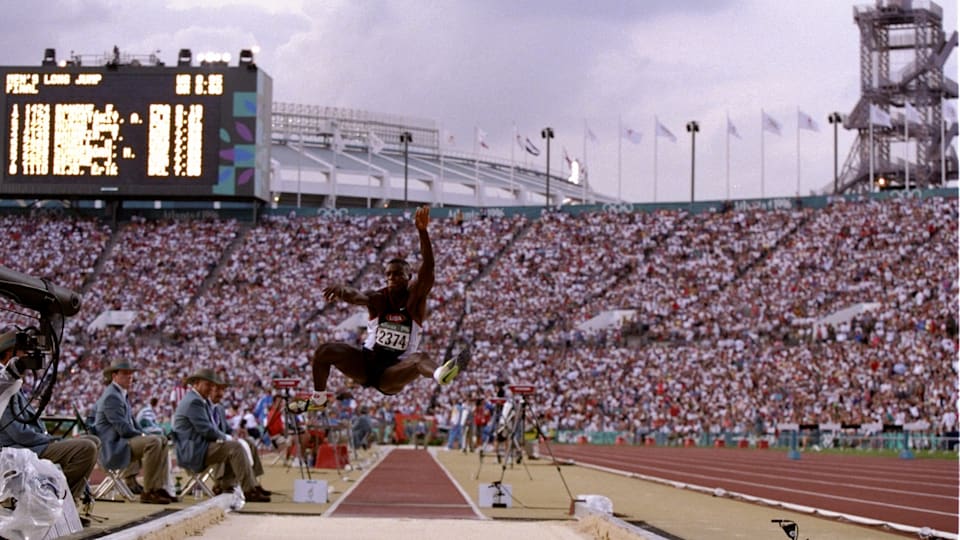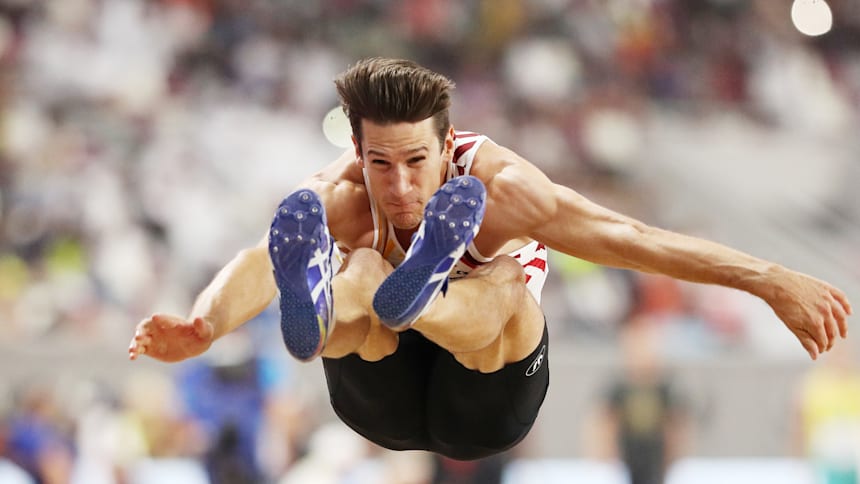
One of the mainstays in ancient Olympiads, the long jump has continued to be a showstopper in modern Olympics as well.
The objective of the long jump is simple – to cover the maximum possible distance with a horizontal jump. However, a deep dive into the details reveals the long jump is one of the most technically difficult track and field events to master.
Long jump rules and technique
Long jumpers start with a running start, propel themselves in the air at a designated launching point, also called the take-off board, and try to achieve maximum distance in the air before landing inside a sand pit.
So, the entire course consists of three parts. The runway, the take-off board and the sandpit to land in.
In official events, the runway measures 40m in length. It is similar to a running track used in sprinting, mid-distance or long-distance running events and is made out of a rubberised material laid over concrete.
At the end of the runway lies a 20cm wide take-off board. The runway and the take-off board must be level with each other.
The end of the take-off board is marked with a foul line. While taking off, the toe of the jumper’s shoe needs to be behind the foul line for a particular jump to be deemed legal. Crossing the line results in a foul jump and doesn’t count.
After being airborne, the jumper lands in the sandpit placed on the other side of the take-off board.
The distance covered, from the edge of the take-off board to the indentation in the sand (made by any part of the athlete’s body while landing) closest to the take-off board, is measured.
The entire jump needs to be completed within one minute after the long jumper steps into the runway. Long jumpers are allowed to wear spikes if they prefer but the sole of their shoe cannot be more than 13mm thick.
At events, an athlete is often given a fixed number of attempts and the one with the longest distance covered, is counted as the best.
In the final rounds of big competitions like the Olympics or World Championships, athletes generally get six jumps. A set of three trial round jumps are held to select the finalists, who then get three more jumps to win medals in the final.
The entire action of a long jump can be further subdivided into four parts – the approach run, the final two strides, the action in air and landing.
The approach run
The approach run is essentially the sprint towards the take-off board barring the final two steps.
A long jumper has 40m of track available to them and in theory, using the full distance is ideal to build up top speeds and consequently maximum forward momentum before starting the leap. However, depending on individual techniques, athletes may choose a shorter run-up to have more control over their leap.
At elite levels, athletes usually take 20-22 steps in their approach run.
The final two strides
These are the final two steps taken before an athlete goes airborne from the take-off board.
To achieve maximum horizontal distance, long jumpers generally try to leave the ground at an angle of 20 degrees or less and the final two strides are meant to prepare the body to achieve that without sacrificing too much forward velocity.
The penultimate stride is generally longer than the last and is dedicated towards lowering one’s centre of gravity to prepare the body for the maximum-possible upward thrust.
The final stride before take-off, meanwhile, is the shortest step as the body’s centre of gravity starts shifting upwards in preparation for the jump.
The take-off
The take-off is the transition from the final step to being airborne.
An athlete needs to ensure that their foot is flat on the ground to have optimum impact as jumping off either the heels or the toes has adverse impacts on the jump.
While jumping off the heels have a braking effect and reduces momentum, jumping with the toes destabilises the body and runs the risk of the legs collapsing under the jumper, thereby severely decreasing the distance covered.
Maintaining proper body posture while take-off is also equally important as proper foot placement.
Athletes mostly use advanced techniques like kick, double-arm, sprint and power sprint or bounding for their take offs. Each has its advantages and disadvantages.
Action in the air
Once airborne, an athlete has little control over the direction and landing. But there are in-flight measures they can take to maximise the distance traversed.
These include techniques of manipulating the body in certain ways while airborne. Commonly, three techniques are used while in the air.

- Sail: The most basic one of the lot, the sail involves the jumper immediately lifting their legs into a toe-touching position after take-off. This allows the body to float or sail in the air longer with the momentum achieved during take-off
- Hang: This technique involves stretching the body and making it as long as possible after being airborne. Both arms and legs are extended to reach the maximum distance possible and the position is maintained until the jumper reaches the highest elevation. At the apex, the jumper shifts their legs forward into a landing position.
- Hitch-kick: Also called climbing or running in the air, the athletes rotate their arms and legs during the flight to maintain balance. This is the most complex of the three techniques.
Landing
While landing, a long jumper’s objective is to glide into the sand-pit rather than just dropping in it. To ensure the closest indention to the take-off board made by their body is at the maximum distance possible, an athlete can turn to several manoeuvres while landing.
Athletes commonly focus on keeping their feet in front of the body at full stretch from the hips. Upon landing, jumpers often make sweeping motions with their arms to help keep the legs up and the body forward.
Long jump training, hence, requires mastery over several types of athletic abilities, particularly sprinting.
Star long jumpers like Carl Lewis and Jesse Owens, hence, have also found success in other track and field disciplines like 100m, 200m sprints and 4x100m relays.
Long jump at the Olympics: History
In the ancient Olympic Games in Greece, the long jump was similar to its modern-day variant barring from one major difference. It involved the use of weights called halteres.
Athletes would carry weights, ranging from 1 to 4.5kgs, in each hand and swing them forward at the take-off point to increase their momentum. It was also one of the disciplines in the popular ancient Olympics pentathlon event, alongside running, javelin throw, discus throw and wrestling.
In modern times, the long jump has been ever-present in the programme since the modern Olympics Games’ inception in 1896. It was also known as running broad jump in the early days.
Until 1912, a variant called standing long jump or broad jump was also present at the Olympics. It was similar to the running long jump but athletes started from a standing position.
Long jump was exclusively a men’s event before the women’s competition was included in the programme, starting the 1948 London Games – almost 20 years after women’s high jump made it into the list.
United States legend Carl Lewis is the most successful men’s long jumper in Olympics history, having won gold medals at four consecutive Summer Games from 1984 to 1996.
Germany’s Heike Drechsler holds the honours in the women’s division with two gold medals and a silver from 1988 to 2000.
Long jump world record
Long jump Olympic record
Long jumps made with wind assistance over 2m/s aren’t counted as official records. However, Mike Powell also holds the wind-assisted record of 8.99m (with wind speeds of +4.4m/s) achieved in 1992 in Sestriere, Italy.


